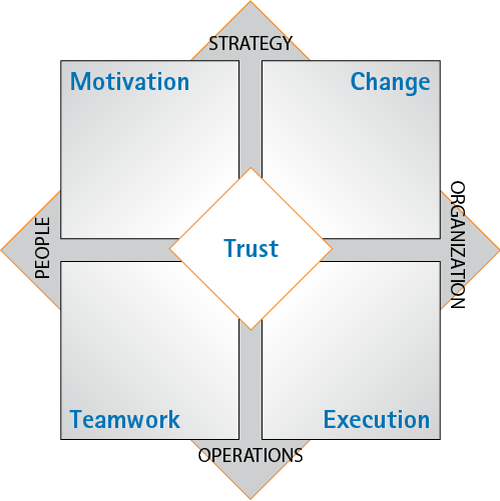When the wave of organizational change hits, teams often get knocked off course – or even pushed underwater. Leading team change, what can you do to keep the change process working while supporting your people through the challenges?

Ideally, we can be leaders of change, with a clear vision of the future, confidently bringing our teams to the next stage of growth. Unfortunately, most managers feel more like “change victims” than “change leaders.” Changes comes as a force from above (or from the market), demanding a new direction.
As a manager, if you are feeling pressure and discomfort from change… what are your employees experiencing? Probably if you perceive the storms of change are “challenging,” many of your employees will say, “horrible.” Fortunately, they have you to support them. Unfortunately, probably you don’t have a lot of time and energy to do so right now.
Even in the ideal circumstances, the process of change is demanding – and exhausting. As a leader of a team, you’re faced with your own struggles with change, and at the same time, you have a responsibility to your people, and the pressures from above.
Looking at the Vital Signs
To support your team to stay vital in the process, start with a diagnosis so you can prioritize. When you go into a hospital, your vital signs are checked – it’s a quick view to see what needs more attention. The Team Vital Signs assessment is a great tool for this, but for now, just give the team a rating (1-10, higher is better) on each of the Vital Signs:
Motivation is the source of energy to overcome challenges, pursue a goal, or maintain commitment. How much strength does your team have today? Are people coming into work full of energy or even excitement? Or are they dragging their feet with dark circles under their eyes?

Teamwork is collaborating to pursue a goal; it requires a sense of shared purpose and belonging. Do you team members feel connected and supported by one another – like allies who are fully committed to their shared work? Or is it more of a group of people who happen to all work for you?
Execution is the ability to achieve strategic results by implementing effective tactics. Do your team members perceive they have the systems and structures to prioritize, efficiently accomplish tasks, and achieve results? Or is their energy wasted, lots of waving arms without real movement forward?
Change is the readiness to innovate and adapt to succeed in a continuously evolving situation. Do your team members feel a sense of openness and readiness for what’s next, and agility to jump into a better state? Or do they feel stuck in a “this is the way we do things here” mentality, with little openness to experimentation?
Trust is a feeling of confidence, faith, and surety that engenders a willingness to risk and facilitates success in the other climate factors. Does your group feel a sense of safety and confidence in the team itself – not just individuals, but the surety that this team will deliver as promised? Or are they doubtful about the team’s ability, as a group, to get results?
Leading team change, harness the power of the Vital Signs assessments, these five drivers are organized into a model that might help you understand your team’s health even better. As you can see, there are two axes, from left-right and up-down. The left-right axis is about people – on the left is individuals; on the right is the group. The up-down axis is about focus – on top is longer-term, more strategic direction; on the opposite end is focus on getting work done today.
Vital Signs Model ©Six Seconds

Strengthening Vitality
If you gave a rating for each of the five Vital Signs, you can use that to prioritize. Other than trust, which of the four is your biggest concern?
On the left, you need to take more care of personal relationships and individual members. To focus here, take people to lunch, listen more, write personal notes, invite people to express themselves.
On the right, pay more attention to the systems, shared connections, culture, and the dynamics. To improve here, ensure you have effective processes for sharing information, defining priorities, tracking progress, providing feedback.

On the top, put energy into the vision, the purpose, the Why. Strengthen this direction by linking change to purpose, talking about why you’re doing what you’re doing. Help people see and feel the connection between what they’re doing and the longer term result.
On the bottom, increase your operative focus – roles, responsibilities, tasks, and deliverables. Make sure people know what’s expected, when, and that there is both individual and shared accountability.
Leading Team Change with Trust at the Center
As you can see in the Vital Signs Model, trust is the central balance point that interacts with all the other dimensions. It’s the “not-really-secret ingredient” that makes all this work. When people feel trust, they are willing to give a little more energy toward their own and others’ motivation. Trust creates permission to take risks to change. Trust builds a sense of connection for teamwork. Trust makes is far more efficient to focus on what’s important to improve execution. The neuroscience of trust is fascinating – as researcher Paul Zak has found, trust has significant economic value – as well as moral value.
If trust is low on your team, you will not weather the storms of change well. For a team trying to thrive in times of challenging change, trust is as important as air. Every small leak must be addressed. Where you can get away with minor breaches of trust “in good time,” in challenging times, everyone is more sensitive, more critical, more afraid.
Often managers excuse bad behavior from some employees – there are often a few people who are not doing their share, or not following the rules, and everyone knows it. Why do we permit it? “It’s too much effort to have the confrontation…” “HR makes it impossible to fire people…” “I don’t have time today.” Remember, as a manager, what you permit, you promote.

Leading team change actually creates an opportunity to respond to some of these dysfunctions. In an extraordinary time, you can have conversations that you don’t normally have. Confront the problem by focusing on the shared goal: “We are in an extremely challenging situation, so all of us will need to do things differently if we’re going to make this work. I’ve observed that you sometimes ____, and during this change, that won’t be allowed. Are you willing to work with me on this?”
One of the little-understood aspects of trust is that it’s something we FEEL. Trust is an emotion that helps us survive. It’s actually connected to the feeling of love – as well as respect and safety. So don’t approach trust only with logic. If team members are not feeling trust, you can’t convince them with facts alone. They need to know that you and their colleagues are committed, responsible, and mutually protective – and they need to feel it.
- Coaching Through the Emotional Recession: Three Practical Tips for Trauma-Informed Coaching - May 1, 2024
- Knowing Isn’t Coaching: Three Emotional Intelligence Tools for Professional Coaches - April 3, 2024
- Coaching Down the Escalator: 3 Emotional Intelligence Tips forCoaches to Reduce Volatility & De-escalate Conflict in a Polarized World - March 6, 2024

